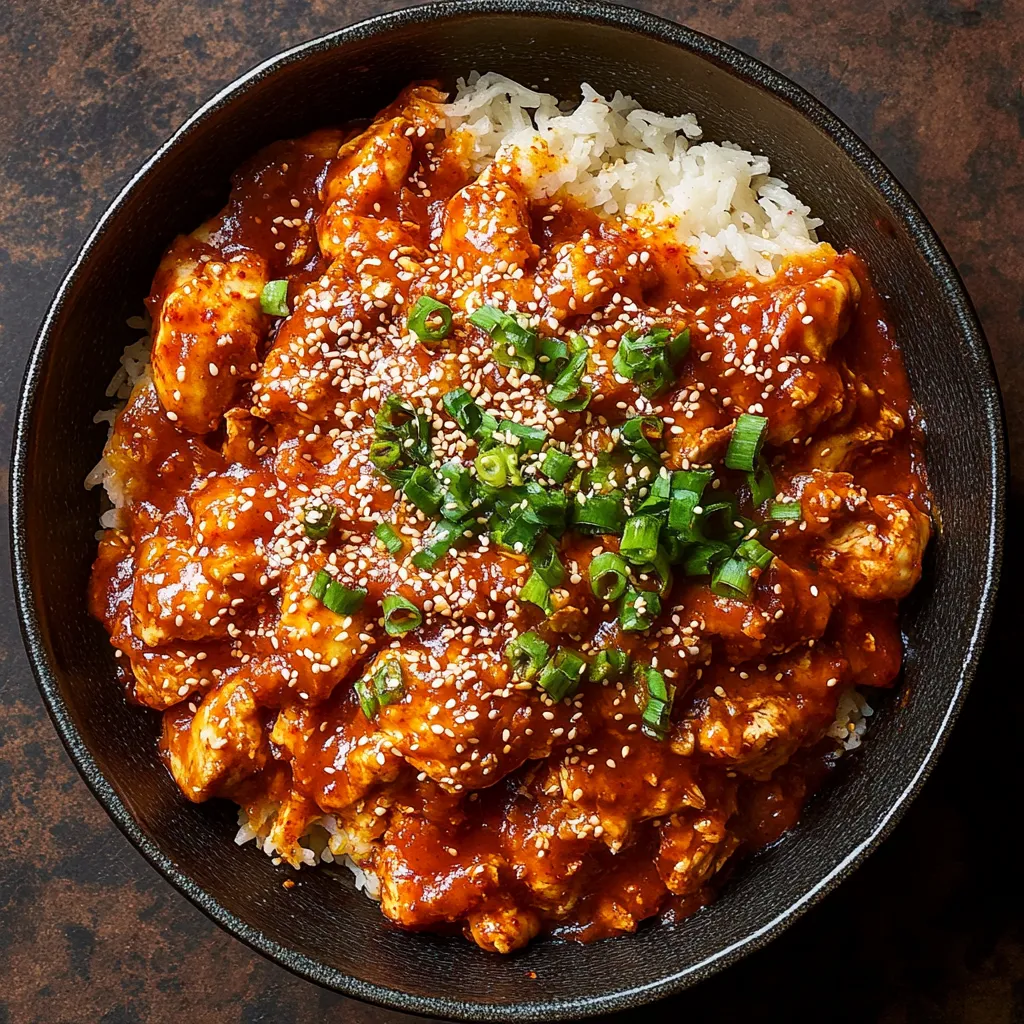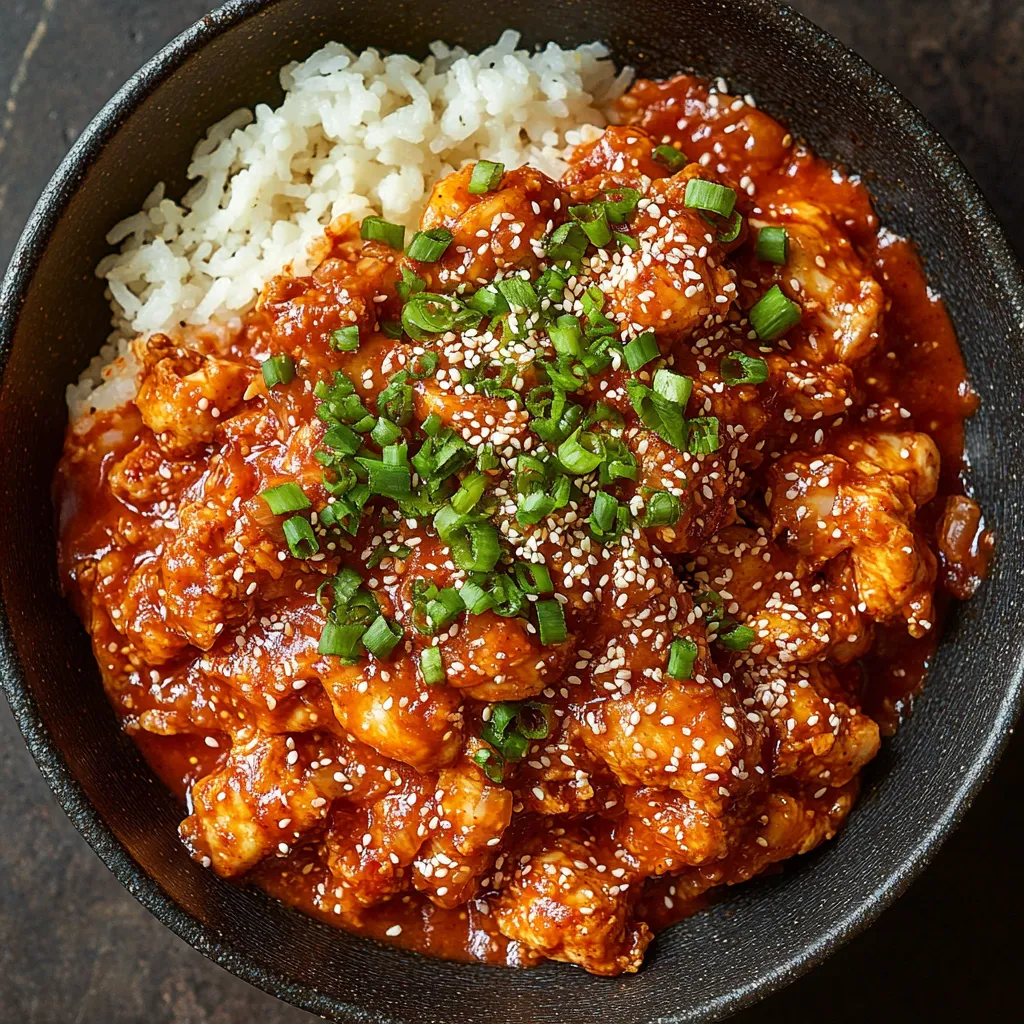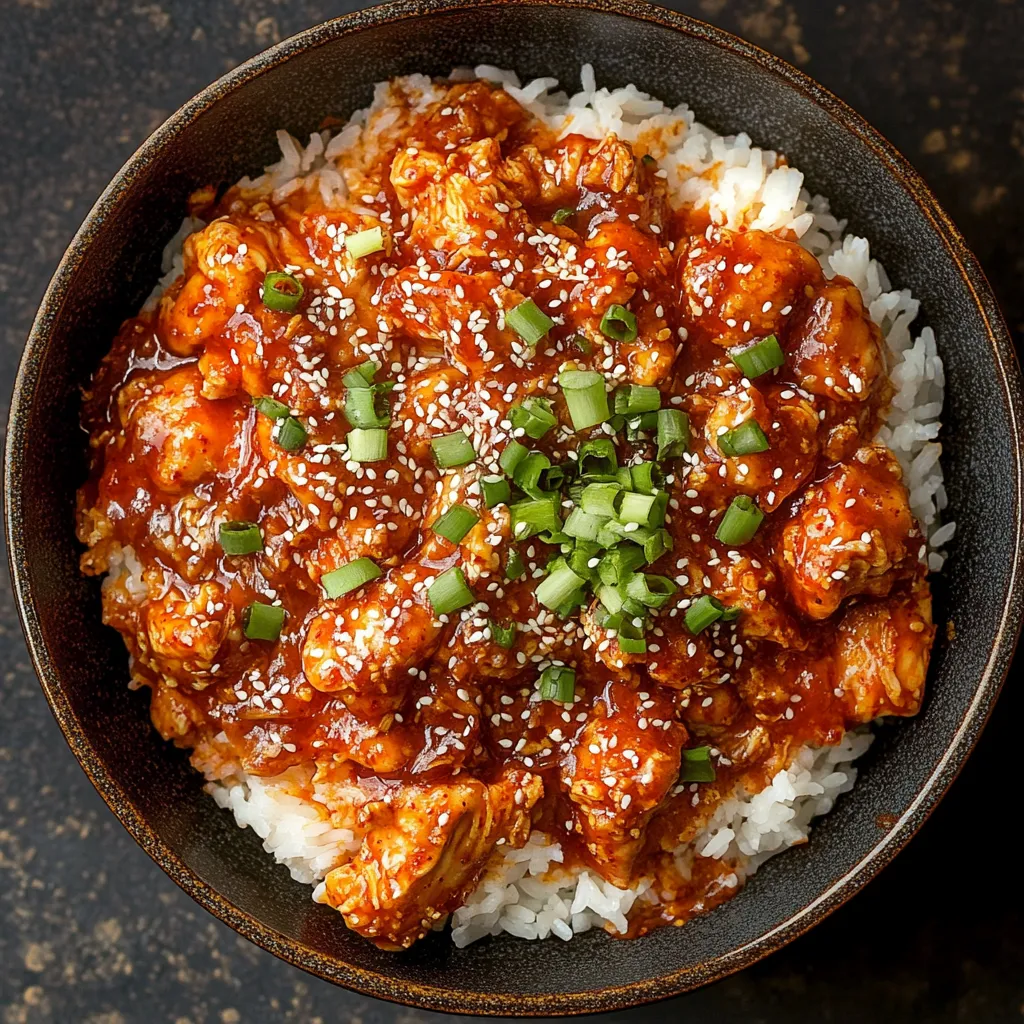 Pin it
Pin it
This fiery Korean Buldak recipe transforms plain chicken into an unforgettable spicy sensation that balances sweetness with intense heat. My dinner guests always leave with their taste buds tingling and asking for this recipe.
I discovered this recipe during my exploration of Korean cuisine and it quickly became my go to dish when friends visit. The combination of sweet and spicy flavors creates such an addictive dish that I now keep gochujang permanently stocked in my refrigerator.
Ingredients
- Boneless chicken breast: Provides a lean protein base that absorbs flavors beautifully. Choose fresh chicken with firm texture.
- Soy sauce: Adds essential umami depth. Use low sodium if watching salt intake.
- Mirin: Sweet rice wine brings subtle sweetness that balances the heat. Look for genuine mirin without corn syrup.
- Gochugaru: Korean red pepper flakes deliver bright vibrant heat. The coarser flakes provide better texture.
- Gochujang: Korean red pepper paste forms the heart of this dish with its complex sweet fermented flavor.
- Honey: Helps balance the spice with natural sweetness. Local raw honey offers best flavor.
- Sesame oil: Provides nutty aroma crucial for authentic taste. Always use 100% pure toasted sesame oil.
- Minced garlic: Infuses aromatic punch throughout the dish. Fresh garlic yields superior results.
- Rice cakes (optional): Add chewy texture contrast. Find these refrigerated in Asian markets.
- Green onions: Bring fresh crunch and visual appeal as garnish. Choose bright firm stalks.
Step-by-Step Instructions
- Prepare the chicken:
- Cut boneless chicken breast into uniform bite sized pieces about 1.5 inches each to ensure they cook evenly. Make sure your knife is sharp to create clean cuts rather than shredded edges that might dry out during cooking.
- Create the marinade:
- Combine 3 tablespoons soy sauce with 2 tablespoons mirin in a bowl large enough to hold all the chicken. This simple marinade provides the foundation flavors that will complement the stronger spices to come. Make sure to whisk thoroughly to fully blend the ingredients.
- Marinate the chicken:
- Add chicken pieces to the soy sauce mixture, stirring gently to ensure each piece gets evenly coated. Allow the chicken to rest in this marinade for 15 to 20 minutes at room temperature. This brief marination time tenderizes the meat while infusing it with savory notes without making it too salty.
- Mix the signature spicy sauce:
- In a separate bowl, combine 2 tablespoons gochugaru, 3 tablespoons gochujang, 1 tablespoon honey, 1 teaspoon sesame oil, and 1 tablespoon minced garlic. Stir until fully incorporated into a smooth vibrant red paste. This combination creates the perfect balance of sweet heat and richness that defines authentic buldak.
- Pan fry the chicken:
- Heat a large skillet over medium high heat until hot. Add 1 tablespoon of neutral cooking oil and carefully arrange the marinated chicken pieces in a single layer. Allow them to develop a golden crust before flipping, about 3 to 4 minutes per side. Work in batches if necessary to avoid overcrowding which prevents proper browning.
- Add the spicy sauce coating:
- Once chicken is fully cooked through, reduce heat to medium low and add the prepared spicy sauce to the pan. Gently toss the chicken pieces to coat them evenly in the vibrant sauce. Allow everything to simmer together for 2 to 3 minutes so the flavors can meld and the sauce can thicken slightly, clinging beautifully to each piece of chicken.
- Finish and garnish:
- Sprinkle freshly chopped green onions over the finished dish just before serving. The bright green color provides beautiful contrast against the deep red sauce, while adding a fresh crunch that cuts through the richness.
 Pin it
Pin it
My absolute favorite part of this recipe is watching guests experience that first bite. The initial sweet flavor gives way to building heat that creates this wonderful endorphin rush. I still remember the first time I made this for my brother who claimed to love spicy food. His eyes watered but he couldn't stop eating it, declaring between gulps of water that it was the best chicken he'd ever had.
Adjusting the Heat Level
Buldak literally translates to "fire chicken" for good reason. The traditional version packs serious heat that might overwhelm some palates. For a milder version, reduce the gochugaru to 1 tablespoon and gochujang to 2 tablespoons. You can also increase the honey to 2 tablespoons for more sweetness to balance the heat.
Serving Suggestions
Traditional Korean meals feature numerous side dishes called banchan. Serve your buldak alongside cooling cucumber kimchi, steamed rice, and perhaps some simple seasoned spinach. The contrast between the fiery chicken and these milder accompaniments creates a balanced meal experience.
Cultural Context
Buldak gained immense popularity in South Korea during the early 2000s as street food vendors competed to create the spiciest chicken dishes possible. It became something of a culinary challenge for young Koreans to prove their tolerance for heat by consuming increasingly spicy versions.
 Pin it
Pin it
Serve this dish with love and watch it become an instant favorite. Buldak truly provides an experience you'll never forget.
Frequently Asked Questions
- → How spicy is Buldak and can I adjust the heat level?
Buldak is traditionally quite spicy, as its name 'fire chicken' suggests. You can easily adjust the heat level by reducing the amount of gochugaru (red pepper flakes) and gochujang (red pepper paste) in the sauce. For a milder version, increase the honey proportion slightly to balance the reduced spice.
- → Can I substitute ingredients if I can't find gochujang or gochugaru?
While authentic flavors come from Korean ingredients, you can substitute gochugaru with red pepper flakes (though the flavor profile will differ slightly). For gochujang, a mixture of miso paste with sriracha or hot paprika paste with a touch of sugar can work in a pinch, though the authentic depth will be somewhat compromised.
- → What are rice cakes and are they necessary for this dish?
Korean rice cakes (tteok) are chewy cylinders made from rice flour. They add textural contrast to Buldak but are optional. The dish is still delicious without them, focusing purely on the spicy chicken. If using them, soak dried rice cakes in water for 30 minutes before cooking to soften.
- → What sides pair well with Buldak?
Buldak pairs wonderfully with plain steamed rice to balance the spice. Banchan (Korean side dishes) like kimchi, pickled radishes, or cucumber salad complement the heat. Some people enjoy melted cheese on top of Buldak, creating a fusion dish that's become increasingly popular.
- → How long does the chicken need to marinate?
A short 15-20 minute marination in soy sauce and mirin is sufficient for Buldak. Unlike some other marinades, this brief soak adds flavor without needing hours of preparation. If you're short on time, even 10 minutes will impart some flavor before cooking.
- → Can I make Buldak ahead of time?
Buldak is best enjoyed fresh when the sauce is glossy and the chicken remains tender. However, you can prepare the sauce in advance and store it in the refrigerator for up to a week. When ready to serve, simply cook the marinated chicken and toss with the pre-made sauce.
